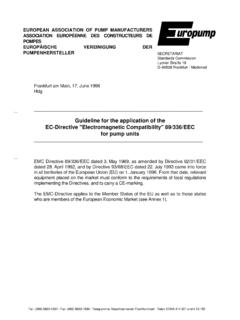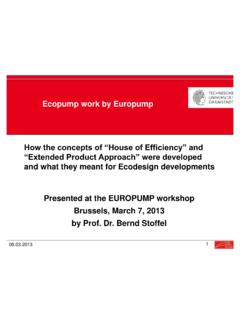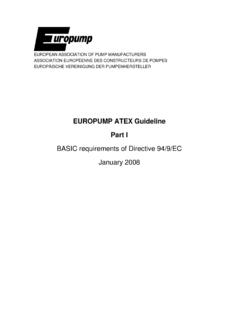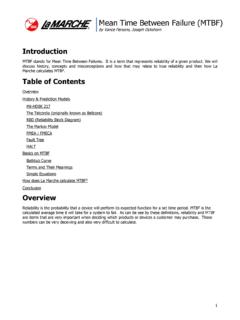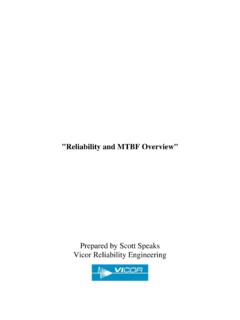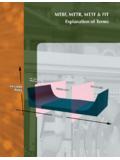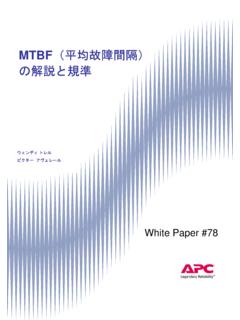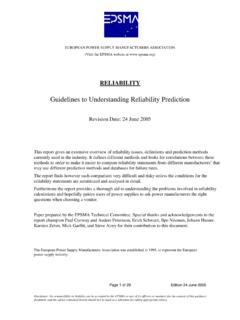Transcription of Improvement of Reliability of Pumps by Condition ...
1 EUROPEAN ASSOCIATION OF PUMP MANUFACTURERS ASSOCIATION EUROP ENNE DES CONSTRUCTEURS DE POMPES EUROP ISCHE VEREINIGUNG DER PUMPENHERSTELLER Europump Guide Improvement of Reliability of Pumps by Condition Monitoring Consequences for MTBR/MTBF July, 2012 Page 1 Table of Content 1. 2 2. INTRODUCTION .. 3 3. GENERAL ASPECTS OF IN-SERVICE Condition MONITORING .. 4 Review of the main indicators .. 4 Monitoring 5 Deterioration 6 4. MAIN INDICATORS FOR IN-SERVICE Condition MONITORING.
2 7 Mechanical Parameters .. 7 Performance Indicators .. 9 5. DESCRIPTION OF METHODS OF ANALYSIS OF THE MAIN INDICATORS .. 12 Mechanical 12 Performance indicators .. 13 Predictive 13 6. CONSEQUENCES FOR MTBR / MTBF .. 15 7. CONCLUSIONS .. 16 8. REFERENCES .. 16 Disclaimer: This Europump Guide is a free guide and intends to highlight the importance of in-service monitoring of pumping systems through the description of the main parameters to monitor and the ways to acquire them. While it attempts to provide accurate information, we make no warranty or representation of any kind with respect to the information included herein or its completeness or accuracy.
3 We are not responsible for any action taken as a result of relying on or in any way using the information contained in this guide and in no event shall be liable for any damages resulting from reliance on or use of this information. We also make no representations as to the accuracy of the information provided in any of the guides linked to this and obviously cannot be responsible for any information contained in those guides. Users should, as with all information or reference material, use their own best judgment as to the usefulness and accuracy of any information presented.
4 This Guide could contain inaccuracies, and changes to the information contained herein may be made at any time. This publication may be freely reproduced, except for advertising, endorsement or commercial purposes. Please acknowledge the source as Europump aisbl. All rights reserved 1st edition July 2012 Page 2 1. SCOPE In any industrial application, the general availability of Pumps can be enhanced by adopting general or customised programs for in-service equipment monitoring, to minimise risks of unpredicted failures and consequent plant outages.
5 The present guide intends to highlight the importance of in-service monitoring of pumping systems through the description of the main parameters to monitor and the ways to acquire them. Also, it will be briefly illustrated how they can be effectively processed and analysed to retrieve valuable information on the status of the equipment under surveillance. This guide is intended to be mainly addressed to operations managers of plants or systems, maintenance engineers, sales and procurement officers, with the aim of offering a clear and concise picture of the importance and the complexity of a Condition monitoring system in an industrial environment.
6 The document consists of two main parts: review of the main indicators for Condition monitoring of a pumping system; description of techniques to acquire and monitor main indicators to predict pump deterioration patterns and plan timely maintenance operations; Auxiliaries and accessories of pumping systems are not included in the scope of the guide. Page 3 2. INTRODUCTION An effective pump Condition Monitoring System (CMS) should be capable of monitoring the operating conditions of Pumps , issue advance warnings of possible faults and predict the residual life span of critical machine components, prior to final breakdown.
7 In order to be successful, the CMS must be based on an in-depth knowledge of the operational process, permitting the identification of critical duties and machines. A combination of process data and conditions of machine components, resulting from an adequate amount of operating hours, represents the fundamental requirement. Hence, the CMS must include the ability to collect and store process data as well as pump operational data. On board sensors should feed process data (such as fluid temperature, flow and pressure, etc) and mechanical data (vibration levels, bearing temperatures etc.)
8 To a higher level system of analysis and interpretation. This system of analysis must be capable of an early detection of the existence of faults and give indications of possible causes, with reference to historical data. In more detail, the CMS must be able to elaborate so-called deterioration patterns , obtained from fault related symptoms. Deterioration patterns can be extrapolated, using sound engineering judgement, or more sophisticated predictive methods, to anticipate the operating conditions of the Pumps in the near future.
9 The elaboration of deterioration patterns can be performed using predictive methods, with the help of expert know-how, more recently supported by advanced statistical techniques, such as: neural networks or neuro-fuzzy techniques, helping to separate spurious symptoms from true fault-related behaviour of the Pumps . Contrary to preventive maintenance, whereas components of a system are replaced preventively during periodical maintenance, CMS should allow Condition -dependent maintenance activity, based on accurate prediction of the residual life of critical components.
10 Conceptually, Mean Time Between Repairs (MTBR), which is the target of predictive maintenance, should be replaced by specific Time Between Repairs for the individual components of the plant, reducing the costs of repairs. CMS can be considered as a tool for process optimisation , achieved by upgrading the life span of critical components to match the time between periodical maintenance activities. Page 4 3. GENERAL ASPECTS OF IN-SERVICE Condition MONITORING Review of the main indicators In order to explain the essence of Condition Monitoring it is a prerequisite to identify and briefly list the main indicators on which it is based and ways they can be obtained or acquired, together with the main outcome they can offer: Flow Liquid capacity is a difficult parameter to measure on site accurately.
